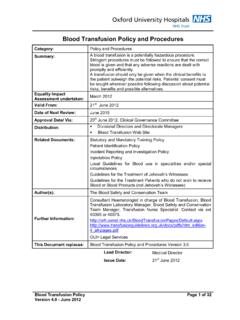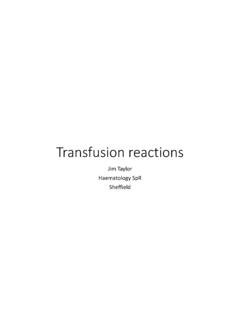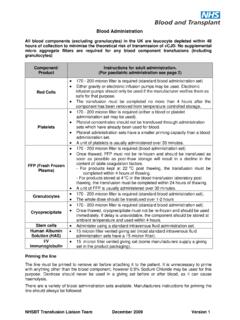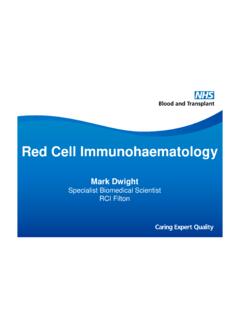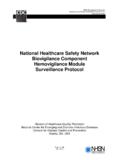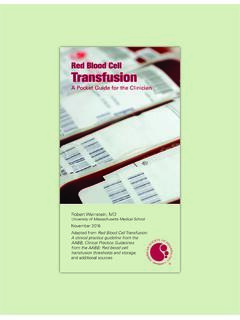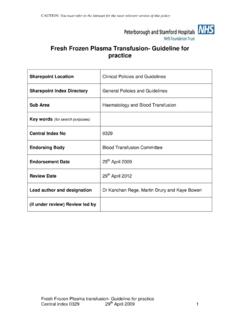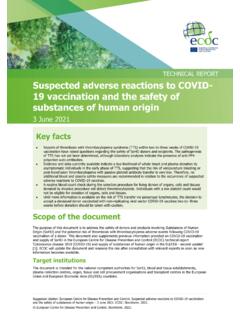Transcription of Handbook of Transfusion Medicine
1 Handbook of Transfusion Medicine 5th editionHandbook ofTransfusionMedicineEditor: Dr Derek NorfolkUnited Kingdom Blood Services5th editionHandbook ofTransfusionMedicineEditor: Dr Derek NorfolkUnited Kingdom Blood Services5th editionPublished by TSO and available from:Online , Telephone, Fax & E-mail TSO PO Box 29, Nor wich NR3 1GN Telephone orders/General enquiries: 0870 600 5522 Fax orders: 0870 600 5533 E-mail: Textphone: 0870 240 3701 TSO@Blackwell and other Accredited AgentsEditor Dr Derek Norfolkc/o Caroline SmithJPAC ManagerNHS Blood and TransplantLongley LaneSHEFFIELDS5 7 JNEmail: Crown Copyright 2013 All rights may re-use this information (excluding logos) free of charge in any format or medium, under the terms of the Open Government Licence. To view this licence, visit or e-mail: Where we have identified any third par ty copyright information you will need to obtain permission from the copyright holders for reproduction should be made in writing to The National Archives, Kew, Richmond, Surrey T W9.
2 Published 2013 ISBN 9780117068469 Printed in the United Kingdom by The Stationer y of figures ixList of tables xiPreface xiii1 Transfusion ten commandments 12 Basics of blood groups and antibodies Blood group antigens Blood group antibodies Testing for red cell antigens and antibodies in the laboratory The ABO system Transfusion reactions due to ABO incompatibility The Rh system Other clinically important blood group systems Compatibility procedures in the hospital Transfusion laboratory Group and screen Compatibility testing Electronic issue Blood for planned procedures 113 Providing safe blood Blood donation Donor eligibility Frequency of donation Genetic haemochromatosis Tests on blood donations Screening for infectious agents Precautions to reduce the Transfusion transmission of prion-associated diseases Blood groups and blood group antibodies Molecular blood group testing 17ivHANDBOOK OF Transfusion Blood products Blood components Labelling of blood components 184 Safe Transfusion right blood, right patient, right time and right place Patient identification Documentation Communication Patient consent Authorising (or prescribing )
3 The Transfusion Requests for Transfusion Pre- Transfusion blood sampling Collection of blood components and delivery to clinical areas Receiving blood in the clinical area Administration to the patient Monitoring the Transfusion episode Technical aspects of Transfusion Intravenous access Infusion devices Rapid infusion devices Blood warmers Compatible intravenous fluids Co-administration of intravenous drugs and blood Transfusion of blood components 395 adverse effects of Transfusion Haemovigilance Non-infectious hazards of Transfusion Acute Transfusion reactions Severe and life-threatening reactions Less severe acute Transfusion reactions Delayed Transfusion reactions 53v Infectious hazards of Transfusion Viral infections Bacterial infections Protozoal infections Variant Creutzfeldt Jakob disease (vCJD) 596 Alternatives and adjuncts to blood Transfusion Autologous blood Transfusion (collection and reinfusion of the patient s own red blood cells) Predeposit autologous donation (PAD) Intraoperative cell salvage (ICS) Postoperative cell salvage (PCS) Acute normovolaemic haemodilution (AnH) Pharmacological measures to reduce Transfusion Antifibrinolytic and procoagulant drugs Aprotinin Tissue sealants Recombinant activated Factor VII (rFVIIa, novoSeven ) Desmopressin (DDAVP) Erythropoiesis stimulating agents (ESAs)
4 Thrombopoietin mimetics Parenteral iron 697 Effective Transfusion in surgery and critical care Transfusion in surgery Red cell Transfusion Bleeding problems in surgical patients newer oral anticoagulants Heparins Antiplatelet drugs Systemic fibrinolytic agents Cardiopulmonary bypass Liver transplantation Transfusion in critically ill patients Red cell Transfusion in critical care Platelet Transfusion in critical care Plasma component Transfusion in critical care Transfusion management of major haemorrhage Red cell Transfusion in major haemorrhage Coagulation and major haemorrhage Platelets and major haemorrhage Pharmacological treatments in major haemorrhage Acute upper gastrointestinal bleeding 86viHANDBOOK OF Transfusion Major obstetric haemorrhage Audit of the management of major haemorrhage 878 Effective Transfusion in medical patients Haematinic deficiencies Iron deficiency anaemia Vitamin B12 or folate deficiency Anaemia of chronic disease (ACD) Anaemia in cancer patients Anaemia and renal disease Transfusion and organ transplantation Renal transplantation Haemolysis after ABO-incompatible solid organ transplantation Haemoglobinopathies 948.
5 6 .1 -thalassaemia major Red cell alloimmunisation in thalassaemia Sickle cell disease Red cell Transfusion in sickle cell disease Red cell alloimmunisation in sickle cell disease Hyperhaemolytic Transfusion reactions Transfusion in haemato-oncology Transfusion support for myelosuppressive treatment Red cell Transfusion Prophylactic platelet Transfusion Refractoriness to platelet Transfusion Selection of compatible blood for patients who have received a marrow or peripheral blood HSC transplant from an ABO or RhD-incompatible donor Prevention of Transfusion -associated graft-versus-host disease (TA-GvHD) Prevention of cytomegalovirus transmission by Transfusion Long-term Transfusion support for patients with myelodysplasia Indications for intravenous immunoglobulin (IVIg) 1039 Effective Transfusion in obstetric practice Normal haematological values in pregnancy Anaemia and pregnancy Iron deficiency Folate deficiency Red cell Transfusion in pregnancy Major obstetric haemorrhage 109vii Prevention of haemolytic disease of the fetus and newborn (HDFN) HDFn due to anti-D Potentially sensitising events Routine antenatal anti-D prophylaxis (RAADP)
6 Anti-D Ig prophylaxis after the birth of a RhD positive baby or intrauterine death Inadvertent Transfusion of RhD positive blood 11310 Effective Transfusion in paediatric practice Fetal Transfusion Intrauterine Transfusion of red cells for HDFn Intrauterine Transfusion of platelets and management of nAIT Neonatal Transfusion neonatal red cell exchange Transfusion Large volume neonatal red cell Transfusion neonatal top-up Transfusion neonatal platelet transfusions neonatal FFP and cryoprecipitate Transfusion neonatal granulocyte Transfusion T-antigen activation Transfusion of infants and children Paediatric intensive care Haemato-oncology patients Major haemorrhage in infants and children 12611 Therapeutic apheresis Therapeutic plasma exchange (TPE) Indications for therapeutic plasma exchange Risks associated with therapeutic plasma exchange Thrombotic thrombocytopenic purpura (TTP) Therapeutic erythrocytapheresis Therapeutic leucapheresis Therapeutic plateletpheresis Therapeutic extracorporeal photopheresis Column immunoadsorption 132viiiHANDBOOK OF Transfusion MEDICINE12 Management of patients who do not accept Transfusion Anxiety about the risks of blood Transfusion Jehovah s Witnesses and blood Transfusion Mental competence and refusal of Transfusion 136 Appendices 139 Appendix 1: Key websites and references 141 Appendix 2.
7 Acknowledgements 147 Abbreviations and glossary 149 Abbreviations 151 Glossary 155 Index 161ixList of figuresFigure Production of blood components and blood derivatives 19 Figure Identity check between patient and blood component 37 Figure Clinical flowchart for the management of acute Transfusion reactions 46 Figure Guidelines for red cell Transfusion in critical care 81 Figure Algorithm for the management of major haemorrhage 84xiList of tablesTable Distribution of ABO blood groups and antibodies 8 Table Choice of group of red cells, platelets, fresh frozen plasma (FFP) and cryoprecipitate according to recipient s ABO group 9 Table Red cells in additive solution 20 Table Platelets from pooled buffy coats 21 Table Platelets from apheresis donation 21 Table Fresh frozen plasma 22 Table Solvent detergent plasma (Octaplas ) 23 Table Cryoprecipitate 24 Table Buffy coat (granulocytes) 24 Table Granulocytes pooled buffy coat derived in additive solution and plasma 25 Table Apheresis granulocytes 25 Table Safe blood administration 30 Table Blood component administration to adults (doses and Transfusion rates are for guidance only and depend on clinical indication)
8 40 Table Investigation of moderate or severe acute Transfusion reactions 48 Table Comparison of TRALI and TACO 51 Table Estimated risk per million blood donations of hepatitis B virus, hepatitis C virus and HIV entering the blood supply due to the window period of tests in use, UK 2010 2012 55 Table Confirmed viral Transfusion -transmitted infections, number of infected recipients and outcomes reported to UK Blood Services 1996 2012 56 Table Licensed indications and summary of dosage recommendations for the major erythropoiesis stimulating agents used in blood conservation 68 Table Platelet Transfusion thresholds in surgery and invasive procedures 76 Table Perioperative management of warfarin anticoagulation 77 Table Perioperative management of patients on heparins 78 Table Suggested indications for platelet Transfusion in adult critical care 82xiiTable Options for fibrinogen replacement 85 Table Normal adult haemoglobins 94 Table Indications for red cell Transfusion in acute complications of sickle cell disease 96 Table Possible indications for elective red cell Transfusion in severe sickle cell disease 97 Table Causes
9 Of platelet refractoriness 100 Table Categories of ABO-incompatible HSC transplant 101 Table Recommended ABO blood group of components transfused in the early post-transplant period 101 Table Indications for irradiated cellular blood components in haemato-oncology patients 102 Table High-priority ( red ) indications for intravenous immunoglobulin an adequate evidence base and potentially life-saving 104 Table Blue indications for intravenous immunoglobulin a reasonable evidence base but other treatment options are available 104 Table Screening for maternal red cell alloantibodies in pregnancy 111 Table Anti-D Ig for potentially sensitising events in pregnancy 112 Table Red cell component for IUT 119 Table Platelets for intrauterine Transfusion 120 Table Red cells for neonatal exchange Transfusion 121 Table Summary of BCSH recommendations for neonatal top-up transfusions 121 Table Approximate capillary Hb Transfusion thresholds used for restrictive Transfusion policies in studies evaluated by the Cochrane Review 122 Table Red cells for small-volume Transfusion of neonates and infants
10 123 Table Suggested Transfusion thresholds for neonatal prophylactic platelet Transfusion (excluding NAIT) 123 Table ASFA Category I indications for therapeutic plasma exchange (first-line therapy based on strong research evidence) 130 Table ASFA Category II indications for therapeutic plasma exchange (established second-line therapy) 131 xiiiPrefaceAlthough the Handbook of Transfusion Medicine has reached a fifth edition, its purpose remains the same to help the many staff involved in the Transfusion chain to give the right blood to the right patient at the right time (and, hopefully, for the right reason). Transfusion is a complex process that requires everyone, from senior doctors to porters and telephonists, to understand the vital role they play in safely delivering this key component of modern Medicine .
